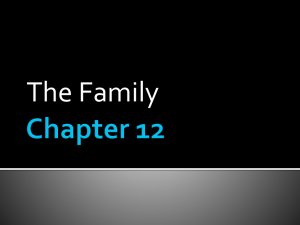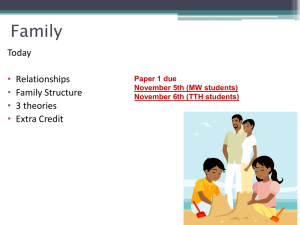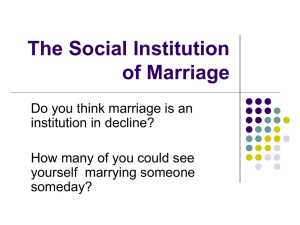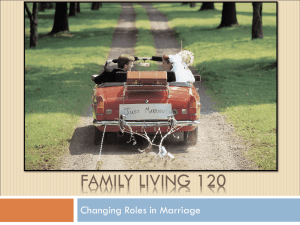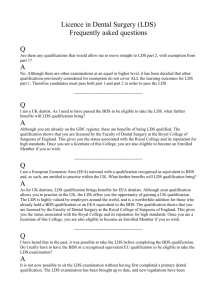Single Adult Woman and Fundamental Christian Norms
advertisement
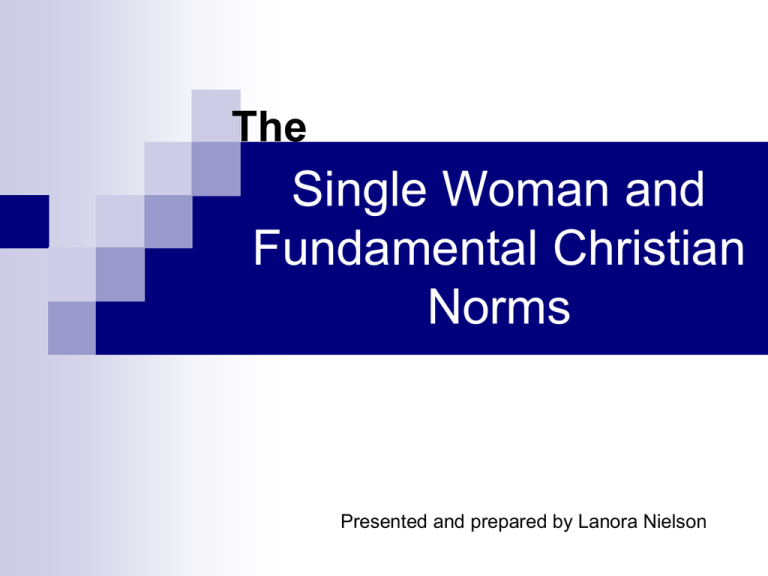
The Single Woman and Fundamental Christian Norms Presented and prepared by Lanora Nielson Purpose and Theory I have a unique opportunity to discuss the impact of being or becoming single in the Latter-day saint culture. I theorize that the need to be married is a constant social pressure from married couples within the LDS religion. I hypothesize that the longer a woman remains unmarried and the more education she achieves, the less she feels social pressure to marry. I theorize that the relationship between how women of the LDS church define what it is to be single in a married culture and the social pressure to become a wife and mother influence her social choices and increase or decrease her desire to marry. Normative Beliefs: The ideal of family, influences how single adults are thought of, and how they think of themselves. A single adult LDS woman is taught from early childhood that she is to prepare to be a wife and mother. This is a social norm for the LDS religion. This expectation is in conflict with the status of remaining single. Whether always single, single from divorce, or single from death of a spouse, the role of wife and motherhood is deeply rooted within Christian religions starting with the order of creation found in Genesis where Adam and Eve were told to multiply and replenish the earth. Therefore, the belief is that to truly be fulfilled a woman must have a husband and children One of the main LDS values taught include that the family unit will be together forever and therefore must be protected and placed as a high priority of self achievement. This then becomes the social norm for an active LDS individual. Expectations: social pressure and religious expectations influence the single adult woman. . Social pressure is defined as the unwanted or uncomfortable feeing associated with being single in a social circle that values the nuclear family. These expectations encourage her to stay within normative boundaries of home and family. Family: A father, who is head of the household. A mother, who has the role of caregiver and children who are the offspring of the father-mother union. All are necessary or the family cannot function properly. (Sherkat, 2000) Literature Review An analysis of research pertaining to how social attitudes influence normative ideals held by society demonstrates how society then influences women and their place in a culture. Cornwall (1989) suggested in her study of religious influences that five factors helped to predict behavior and initiate social control. a sense of community, the religious commitment, the belief in the religion, and religious socialization and demographics, were all a significant part in influencing normative beliefs of a culture. These cultural beliefs provide an individual with a social norm for individualistic action and inclusion into a group. The inclusion into the social order of a group then influences conformity (Cornwall, 1989). Wilson and Musik (1996) studied religion and marital dependency. They suggested that religious affiliation was found to increase maritaldependence by influencing the value placed upon marriage and the threat of possible loss of the relationship. Dependence upon marriage was also found to increase with frequent church attendance. Wilson and Musik (1996) also found that wives who went to church often, were more likely to see marriage as beneficial. The study also revealed that a woman’s age, education and job experience lessened the dependence that a woman places upon marriage (Wilson & Musik, 1996). Mihelich and Storrs (2003) studied the way that women in the LDS church negotiated cognitive dissonance derived from gaining an education in a church that places women as primarily wives and mothers. They found that the religious ideals of wife and motherhood were justified by the belief that an education would help them be better wives and mothers and that school was thought to be good place to find a husband (Mihelich & Storrs, 2003). Sherkat (2000) found that the higher education a woman obtained, and the larger income potential a woman gained, the less likely she was to become a housewife and remain housewife. However the stronger the woman’s fundamental Christian belief, the more likely she was to choose to be a homemaker (Sherkat, 2000). (DePaulo & Morris, 2005). revealed the common attitude of ‘society’ places a single person in the category of singleism. Singleism is defined as the “single adults in contemporary American society that are targets of stereotyping, prejudice and discrimination.” They found that the general attitude of the people that they interviewed believed that to be single is to be an unhappy unfulfilled individual. The cultural idea of what a single is, becomes defined by what a single is not, that is, a single is not married They further suggested that marriage and having a family are versions of the American Dream and the ideology of having a marriage and family are in essence a path and guide through life Therefore, to be single is failing short in some way of that dream. “To women especially, the ideology dangles the romantic fantasy of a Prince Charming or a magical and heroic knight who will turn a sad single, into a resplendent queen.” This is what they term as the Glass Slipper effect. (Link & Phelan, 2001). Found a person is also stigmatized when that individual experiences a loss of status, that is a downward placement in the status hierarchy because financial ability They suggested that a downward placement in status can affect the outcome of self-esteem, housing and medical care, this then becomes a source of discrimination. further suggesting that a low status might make a person less attractive to socialize with and therefore have negative effects for further opportunities within the culture. (Schalkwyk, 2005): A single woman negotiates a harmony with herself and her religion by recreating her worldview about her status as single. One of the ways that a woman accomplishes this task is by changing the myth of wife and mother. using language to describe herself and her new role. suggested that the ideas that society encourages pertaining to marriage are a social construct of shared histories and cultural norms By changing how a woman describes herself and her role, she can reconstruct the value she places upon being single. “Reconstructing the self…implies a new positioning, a new language, new memories, and a new sense of personhood that challenges the dominant discourses” (Schalkwyk, 2005, p. 7). Obtaining and maintaining outside relationships such as close friends, becomes another way that a woman changes her worldview of being single She then recreates a myth for herself by her use of language and outside relationships. The new myth then influences how she views herself as a single woman in a married culture Proposed hypotheses /Research questions: I theorize that the desire to become married is influenced by social pressure from other LDS couples and this pressure is fueled by fundamental Christian values. H1 the longer a woman remains unmarried, and the higher her education, the less feels marriage is necessary for happiness. H2 the longer a woman remains unmarried, the less that she feels the social pressure to remarry in order to conform to normative fundamental Christian teachings. H3 the longer a woman remains single the less she needs to remarry for financial purposes. R1 is there a correlation between the amount of time a woman is divorced and a decrease in her desire to remarry. R2 is there a correlation between changes in education and a decreased desire to marry. R3 do LDS values and social expectations increase a woman’s desire to marry. Methodology I collected 100 surveys. These surveys were completed by women ranging in age from 20 to over 50. These women were single by, divorce, never married, or widowed. The survey highlighted their beliefs and values concerning marriage in relation to age, education, and length of time single. I primarily looked at the demographics; belief in their religious doctrine, age, education, single status, and length of time single. * I then correlated the demographics with three questions. R1 is there a correlation between the amount of time a woman is divorced and a decrease in her desire to remarry. The data illustrates that while 33.3 percent of women divorced from 6 to 10 years agree that marriage is not necessary for happiness, 40 percent who have been divorced from 11 to 15 years disagree that marriage is not necessary for happiness. The data supports that the longer a woman is single and the higher her education the higher likelihood that she agrees that she wants to be married R2 is there a correlation between changes in education and a decreased desire to marry. This question displays interesting results, for the higher a single woman’s education the more she fees social pressure to marry but the stronger her agreement that marriage is not necessary for her happiness and the less her agreement about wanting to be married. In addition, 45 percent of single women with an associate degree agree that marriage is not necessary to be happy, and only 35 percent with a baccalaureate degree agree. Demonstrating an increase in a desire to be married the higher her education. R3, do LDS values and social expectations increase a woman’s desire to marry. To answer this question I turned to the statement of belief. The data would suggest that the single adult women who accepted their churches doctrine without question had a higher percent of agreeing that they felt social pressure to marry at 28.1 percent. They also had a higher percentage of strongly agreeing that they wanted to be married at 53.6 percent. However, they were split in their belief that marriage was necessary for happiness. Conclusion: This research project explored and looked for significant trends that might suggest significant differences that could be researched in greater depth. Furthermore, this research was an attempt to encourage open discussion on normative beliefs for single adult women in fundamental Christian religions. I hope that this research will allocate new perspectives on social expectations for single adult women who feel compelled to marry or for those who remain single. I have tried to bring new sensitivity to the social myth of what it means to be single and new perspectives on if that myth remains true for the women who hold that title. References Beck, J. B. (2007) Mothers who Know. In The Ensign: proceedings of the 177th General Conference of the Church of Jesus Christ of Latter-day Saints 37 (11), pp. 76-78. Salt Lake City, Intellectual Reserve Inc. Cornwall, M. (1989) The Determinants of Religious Behavior: A Theoretical Model and Empirical Test. Social Forces 68 (2), pp. 572-592. Retrieved September 24, 2007, from JSTOR database. DePaulo, B. M., & Morris W. L. (2005). Singles in Society and in Science. Psychological Inquiry 16( 2 & 3)pp. 57-83. Retrieved September 28, 2007, from JSTOR database. Link, B.G. & Phelan, J. C. (2001). Conceptualizing Stigma. Annual Review of Sociology 27, pp. 363-385. Retrieved September 28, 2007, from JSTOR database. Mihelich, J. & Storrs, D. (2003). Higher Education and the Negotiated Process of Hegemony: Embedded Resistance among Mormon Women. Gender and Society 17( 3), pp. 404-422. Retrieved September 24, 2007, from JSTOR database. Schalkwyk, G.V. (2005). Explorations of Post-Divorce Experiences: Women’s Reconstructions of Self. ANZJFT 26( 2), pp. 90-97. Retrieved September 24, 2007, from JSTOR database. Sherkat, D.E. (2000). That they be Keepers of the Home: The Effect of Conservative Religion on Early and Late Transitions into Housewifery. Review of Religious Research 41( 3), pp. 344- 358. Retrieved September 28, 2007, from JSTOR database. The Church of Jesus Christ of Latter-day Saints. (1995). The Family: A Proclamation to the World.[Brochure] Salt Lake City, Intellectual Reserve, Inc. The Holly Bible: King James version (1985). New York, Abradale Press Wilson, J. & Musick, M. (1996). Religion and Marital Dependency. Journal for the Scientific Study of Religion 35 (1) pp. 30-40. Retrieved September 28, 2007, from JSTOR database.
